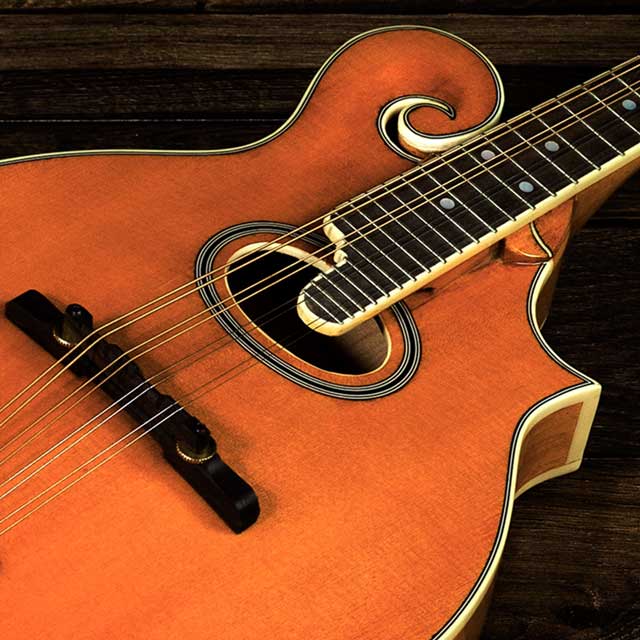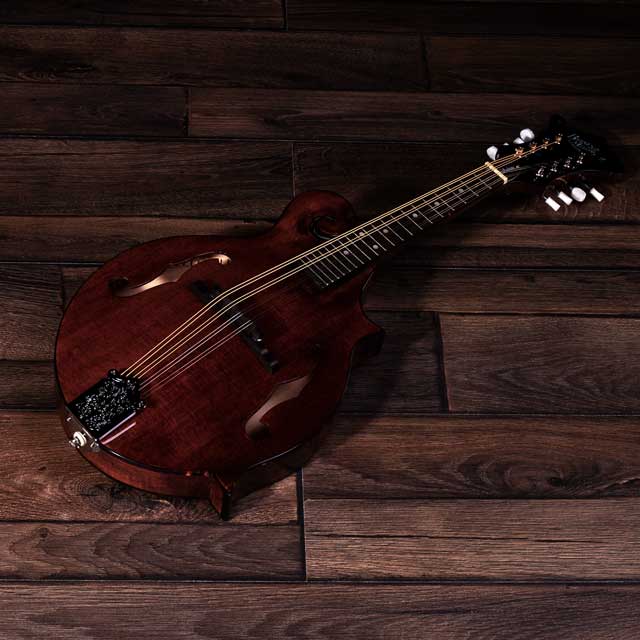
Mandolin Faqs
A-style & F-style mandolins… what’s the difference?
 The two most common types of bluegrass mandolins are the A-style and F-style mandolin. The terms refer to the shape of the mandolin’s body.
The two most common types of bluegrass mandolins are the A-style and F-style mandolin. The terms refer to the shape of the mandolin’s body.
A-style mandolins feature a tear drop or pear-shaped body with the upper sections of the body curving into the neck.
F-style mandolins feature an upper body scroll and scrolled headstock – making them aesthetically distinctive vs. A-style mandolins. Their more elaborate body and headstock design naturally uses more tonewood materials and requires a greater level of craftsmanship – therefore meaning F-style mandolins cost more than their A-style brethren.
A-style mandolins are historically favoured by folk musicians with F-style mandolins more commonly used for bluegrass music – however these aren’t their exclusive domains and both types can be used across a wide variety of musical styles.
In terms of sound and playability, the differences are largely cosmetic with both styles performing similarly. There is little discernible difference in the sound produced other than F-style mandolins arguably being ever so slightly more resonant due to their larger body chamber and tonewood area.
It’s worth considering that given their smaller body design, A-style mandolins can feel more compact and therefore easier to handle and get to grips with for beginners.
Essentially, there is no right or wrong answer as to whether you should buy an A-style or F-style mandolin. You can expect a very similar feel and sound from both, meaning the decision often comes down to which style has more personal visual appeal to you.
We have a range of A-style and F-style mandolins here at Barnes & Mullins, including electro models.
How should I play my mandolin?
 The mandolin is generally played with a pick (plectrum) rather than with your fingers. Strumming and picking techniques can be applied depending on the style or piece of music you’re performing.
The mandolin is generally played with a pick (plectrum) rather than with your fingers. Strumming and picking techniques can be applied depending on the style or piece of music you’re performing.
Having mastered basic strumming and picking techniques, it’s worth learning a technique called ‘cross-picking’. Cross-picking is a picking pattern that is performed over your chord changes to articulate individual string nuances of chords and the finer elements of the melody in a song.
This technique isn’t overly difficult to grasp once you’re well on your mandolin playing journey and will really bring your playing to life.
How should I tune my mandolin?
 Standard mandolin tuning is the same as the violin – G, D, A, E from low to high.
Standard mandolin tuning is the same as the violin – G, D, A, E from low to high.
Of course, the mandolin has eight strings arranged in four sets of two strings tuned to the same pitch - so in full, your mandolin is tuned G, G, D, D, A, A, E, E.
As with any string instrument, the mandolin can be tuned in several different ways. Take a look at our ‘Mandolin Tunings’ page HERE to learn these.
Is it easy to learn the mandolin?
 Fortunately, the mandolin is easy to learn. Despite featuring eight strings, they are arranged in four sets of two strings tuned to the same pitch and therefore learning mandolin tablature and mastering chord shapes is relatively easy as you’re working with chords covering only four strings – much like a ukulele.
Fortunately, the mandolin is easy to learn. Despite featuring eight strings, they are arranged in four sets of two strings tuned to the same pitch and therefore learning mandolin tablature and mastering chord shapes is relatively easy as you’re working with chords covering only four strings – much like a ukulele.
Mandolins are relatively compact and lightweight compared to larger string instruments such as the acoustic guitar or banjo. They are therefore comfortable to handle as they sit close to your body and don’t require too much in the way of stretching while navigating the neck. Their small size also means you can easily carry them to your lessons, rehearsals and performances.
The mandolin fingerboard and frets are also relatively small and many of the fundamental chords can be played using only two fingers – unlike other string instruments with chords that require the use of more fingers and that also dictate your fingers cover a greater distance to achieve them.
What type of mandolin should I buy?
 The mandolin instrument family features many similar instruments that can easily be confused for a mandolin. The mandola looks very similar but is tuned a fifth lower (C,G,D,A) and is slightly larger than a mandolin, whereas the bouzouki is tuned an octave lower and features a longer scale length.
The mandolin instrument family features many similar instruments that can easily be confused for a mandolin. The mandola looks very similar but is tuned a fifth lower (C,G,D,A) and is slightly larger than a mandolin, whereas the bouzouki is tuned an octave lower and features a longer scale length.
When it comes to the standard mandolin, there are two main types – 'classical’ (also referred to as ‘Neapolitan’ and ‘bowl-back’) and ‘bluegrass’ (also referred to as ‘archtop’ and 'flat-back') mandolins. These are further categorised into more variations based on sound hole design and body shape (A-style & F-style… more on this below).
Classical mandolins feature large round voluminous backs - resembling traditional lutes - and are less commonly played as they are generally the choice of musicians who play historical baroque and renaissance styles of music.
Their modern ‘bluegrass’ archtop and flat-back mandolin counterparts were developed in America in the late 19th century. They feature f-shaped or oval sound holes and shallower, slightly curved or flat-backs. They are used more widely throughout American, Irish, British and Brazilian folk music, as well as throughout an ever-growing list of modern musical genres into the 21st century.
This is the style of mandolin you’ll most likely be familiar with.
Why doesn’t my mandolin sound very good?

- As with all stringed instruments, it is important to make sure your mandolin is tuned correctly. Just one or two strings ever so slightly out of tune can make your chords and playing sound unpleasant. It’s always best to tune your mandolin with an electric chromatic tuner before playing. Find out more about mandolin tunings HERE
- It is important you change your mandolin strings frequently. Old and worn strings will have a detrimental effect on the way your mandolin sounds by deadening its overall tone and volume. Dirty and oxidised strings also won’t allow your fingers to glide over them easily, so your mandolin will also feel unpleasant to play. We generally recommend changing your strings around every two months if you’re someone who spends an average amount of time practicing.
- Keep an eye on your bridge and nut. Although it takes a long time, bridges and nuts can wear and drop over time. These vital components play a key role in delivering individual string articulation and an overall balanced tone and can be a pesky culprit if your mandolin starts to sound bad. As a mandolin features eight strings spaced closely together in sets of two, it’s easy for your strings to become unseated from the grooves in your bridge and nut and to start buzzing or cutting out.
- Check your intonation. Without getting into the extensive specifics of what exactly intonation is (we could be here a long time!), poor intonation is a common cause of why your mandolin can suddenly sound bad. Essentially, intonation refers to the relationship between the position of the bridge in relation to the overall length of the string (scale length). If your bridge isn’t positioned incorrectly – and remember, mandolin bridges aren’t fixed to the body like guitars, so they can easily move – it can cause chords to sound odd despite the mandolin being in tune. A good way to test whether your intonation is correct is to play chord shapes higher up the neck. If they don’t sound as they should, this is an indicator that your intonation is out, and that your mandolin isn’t ‘in tune with itself’. You’ll need to make some small adjustments to the position of your bridge until you hit the sweet spot. Remember that your bridge should be positioned at the same distance from the 12th fret as the nut is from the 12th fret in the other direction at the top of the neck. If your mandolin has f-holes, these act as handy guides as you’ll want to locate your bridge in line with the notches in the f-holes.
- Remember to wind your strings the correct way. It sounds simple but you will be amazed at how easy it is to make this mistake as a beginner. Make sure that you wind your strings around the tuning pegs at the headstock from the inside to the outside – so that the top two strings are wound anti-clockwise, and the bottom two strings are wound clockwise.
- As with all wooden instruments, changes in temperature and humidity can affect the moisture content in the tonewoods and therefore affect how your mandolin sounds and plays. Although not such an issue in temperate climates, it is something to pay special attention to if you live somewhere with a particularly hot or cold climate. It is always a good idea to store your mandolin in its case or gigbag with a humidifier when not being played, no matter where in the world you live. Make sure not to leave it too close to something hot like a radiator or outside in the cold.
It’s important to consider that adjusting any instrument without suitable knowledge and experience can cause permanent damage and we therefore always advise you to take your mandolin to a trained luthier for any extensive set-up work.
To ensure your mandolin reaches you in its optimal playing condition, each instrument is inspected and set up by our expert technical team in the United Kingdom before making its way to our retail partners.
-
Do you have a question we have not answered here? Please get in touch with us HERE
